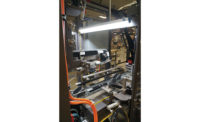Automation
How 4 OEMs Implemented PackML
Four OEMs share their experiences implementing PackML in machine design and build.




Many packaging machinery manufacturers find that implementing PackML across a machine product line isn’t as difficult as first thought and that the rewards exceed expectations. By implementing PackML, OEMs experience:
- Faster specification, design, build and engineering processes.
- Easier product testing and shorter commissioning times.
- Quicker product turnaround and payment cycles.
- Lower warranty costs.
- Easier customer training, aftermarket problem resolution and service.
- Faster new product development times.
- Higher quality final products.
Matrix- Marc Wilden, vice president
Matrix adopted PackML when the company was developing its first continuous motion, vertical form fill seal machine in the Morpheus line. Matrix found PackML architecture a convenient way to segregate different areas that needed to be developed. PackML’s inherent modularity made it easier to work with and divide tasks among external and internal partners in product development. Matrix thought the learning curve involved in adopting PackML was trivial compared to these real benefits.
Matrix has been able to reuse most of the code it wrote using PackML. Matrix found that the 10 percent more effort it took to introduce PackML to internal and external partners allowed 90 percent of the code to be reused.
PackML also helped Matrix gain a huge degree of cross-compatibility among products. Matrix took 90 percent of the code it wrote for the continuous motion Morpheus machine and reused it on a new intermittent motion machine — saving
design, engineering and build time.
Matrix found that PackML reduces engineering time and is scalable and efficient. This has resulted in shorter commissioning time for machines and significant savings in costs and time, instead of building machines from scratch. Lead times have been reduced 25-30 percent.
During Factory Acceptance testing for Matrix’ first PackML machine, the customer — which wondered why PackML was used — discovered quickly how easy it is to identify issues, check a module and resolve it. Now that customer requires PackML on all of the machines it buys.
Axon- Christopher Thomas, director of Controls Technology and Ken Nyren, Engineering manager
By implementing PackML, Axon cut debug testing time by 60 percent. Overall engineering and manufacturing time was reduced 40 percent, including building and debugging. Total allotted testing time for Axon machines is a fixed period, but the time from machine start-up and testing also went down 40 percent. Now, 80 percent of the company’s code is reusable and standardized across its machines.
Axon found that once it absorbed the initial upfront cost of implementing PackML, the payoff was well worth it. Five years into using PackML, Axon can turnaround machines faster. Modules are already tested.
Service technicians can frequently make a few minor adjustments or debugs remotely with a laptop. The modularity and simple standardization have resulted in higher quality machines and lower warranty costs.
Now that Axon has a mature PackML code base to use, it can implement a new machine much faster, including a fully developed PLC program and HMI. The added benefit is few, if any bugs, because most of the reused code has already been tested and debugged.
PackML has helped Axon use a common HMI design language. This means greater consistency among models. Service technicians don’t have to worry about every machine being different, which significantly reduces training and support calls.
Axon develops all their machines to be PackML compliant, even if it is not requested by customers. For end-user customers who know the benefits of PackML and want it, Axon believes its experience with PackML gives the company a competitive advantage. Customers who don’t specify PackML typically realize the benefits it provides once they have more experience with it.
A good starting point is to begin with something common across multiple machines. You should understand how the code works and how you can transfer it from machine to machine. This opens the door to the possibilities and gets your team and others in your organization excited about pushing forward. A real benefit of PackML is the ability to reuse modules. It also helps engineers identify commonality between machines and increase code reuse from across machines. Over time the code base will grow, and by the second machine you don’t have to do it all over again.
Mettler-Toledo- Tom Dorward, product manager
Mettler Toledo (mt.com) started looking at PackML when it was developing a new control platform that needed to communicate machine conditions to a customer’s control system. PackML is now the standard for all Mettler Toledo Product Inspection machinery and a fundamental requirement for all higher-level communications products.
Once Mettler-Toledo decided to go forward with PackML, it accounted for a very small portion of overall control development. PackML was a defined standard solution. The machine communications requirement was already in the spec. With standard code and tag definition, Mettler Toledo was able to reuse code and eliminate custom development, which reduced engineering cost and time. Since Mettler Toledo’s implementation of PackML is always the same, documentation remains consistent. Engineering design and test time were dramatically reduced once the software was written. Mettler Toledo’s focus is now on improvement rather than repetitive development.
Mettler Toledo’s support team also can now focus on connectivity solutions using a common knowledge base for data and commands, making it easier for them to quickly identify issues and resolve problems.
Mettler has extended PackML across multiple product lines — checkweighing, product inspection machines (metal detection, vision, and X-ray). PackML use has broadened from Fieldbus to OPC and the product inspection data collection system, ProdX. Following a standard that is applied across multiple products and manufacturers provides customers with a consistent platform to integrate their lines.
ID Technology- Mark Will, automated systems engineer
ID Technology found PackML to be an ideal solution that could be scaled down to fit in the control systems of its labeling and marking equipment.
PackML’s modularity allowed ID Technology to isolate the essential states required for its systems. By using just the required PackML states necessary for ID Technology equipment helped them quickly get up to speed on implementation. That benefit has carried over into faster coding and reduced development time.
ID Technology now reuses code across platforms, resulting in reduced engineering hours and consistency across product lines.
Mettler Toledo, Axon, Matrix and ID Technology design and build vastly different types of packaging machinery and took different approaches to implementing PackML. The results from implementing a modular, consistent standard across their product lines were similar. All four OEMs realized cost and time savings, as well as product consistency that benefitted them.
Looking for a reprint of this article?
From high-res PDFs to custom plaques, order your copy today!








